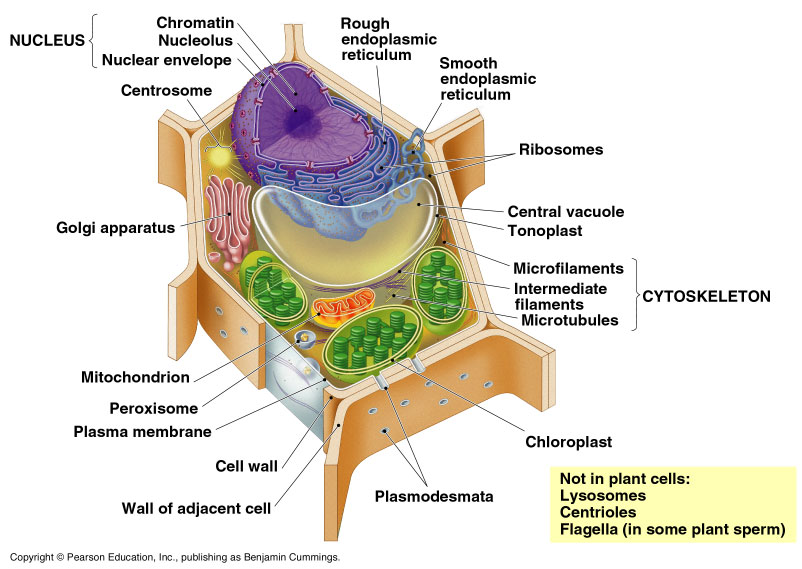PLANT BIOLOGY FOR NON-SCIENCE MAJORS
Department of Cell Biology & Molecular Genetics
![]()
Department of Cell Biology & Molecular Genetics
![]()
The Plant Cell
I. Introduction
A. What is a
cell?
B. Life is organized
on many structural levels:
C. What are
oganelles?
II. Plant Cell Size
A. Between 10
- 100 µm long.
B. Light microscope
is used to view plant cells.
III. Plant Cell Functions
IV. Types of cells
A. Prokaryotic
B. Eukaryotic
V. Plant Cell Structure
A. Outside of
the cell
1. Cell wall
a) Cellulose and Lignin
B. Inside the
cell
1. Nucleus: controls cell activities, stores genetic material (DNA)
2. Cytoplasm: plasma membrane inward and includes the cytosol, organelles,
endomembrane system, cytoskeleton, and ribosomes.
a) plasma membrane (cell membrane): phospholipids and proteins
b) cytosol: watery material inside the cell
c) other membrane bound organelles
(1) mitochondria: sugar ---> energy (aerobic respiration)
(2) chloroplast: photosynthesis
(3) ribosome: protein synthesis site
(4) vacuole: cell waste and storage dump site
d) endomembrane system
(1) endoplasmic reticulum (ER): channels materials throughout the cell
(2) Golgi apparatus: processes/packages materials for secretion or use
within the cell.
e) Cytoskeleton (microtubules and actin filaments): movement of cell and
movement within cell.
VI. Chemical compounds that make
up the plant cell
A. Water, ions,
and organic molecules
B. Macromolecules:
Carbohydrates, Lipids, Proteins, Nucleic acids
1. all consist of C, H, and O (nucleic acids and some lipids have N and
P)
2. all are polymers
Carbohydrates (the most abundant
macromolecule; releases energy when broken down)
A. Functions:
energy storage (sugar, starch, glycogen) and structure
B. Structure
1. building blocks are monosaccharides (single sugar)
2. polymers are disaccharides (sucrose, lactose) and polysaccharides (starch,
glycogen, and cellulose are glucose polymers)
Lipids (fats, oils, phospholipids,
and waxes)
A. Structure:
building block is a glycerol molecule and fatty acid(s), differ in
chain length and saturation
1. polymers are mono-, di-, and tri-glycerides (triglycerides are fats
or oils)
2. phospholipids: glycerol, 2 fatty acids, and a phosphate. Important
components of cell membrane.
B. Functions:
store high energy; components of membranes; water proofing (waxes); pigments;
steroids and hormones.
Proteins
A. Structure:
building blocks are 20 different amino acids (the monomers)
B. polymers
can be 100-1000 amino acids long, specific sequences, many possibilities.
1. Amino acid = H atom + acid group + amino group + variable R group.
2. Variable R group gives it unique properties.
C. Function:
structural components, storage, defense, enzymes, transport.
Nucleic acids
A. Function:
genetic material (stores and transmits hereditary information)
1. DNA: deoxyribonucleic acid; double helix
2. RNA: ribonucleic acid; single stranded
B. Structure:
polymers of nucleotides (monomers)
1. Nucleotide = 5 carbon sugar + phosphate group + nitrogen base.
Nitrogen bases are A, G, C, T and U
2. T found only in DNA. U found only in RNA.
C. Base pairing
rules: In DNA: A pairs with T; G pairs with C
